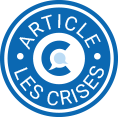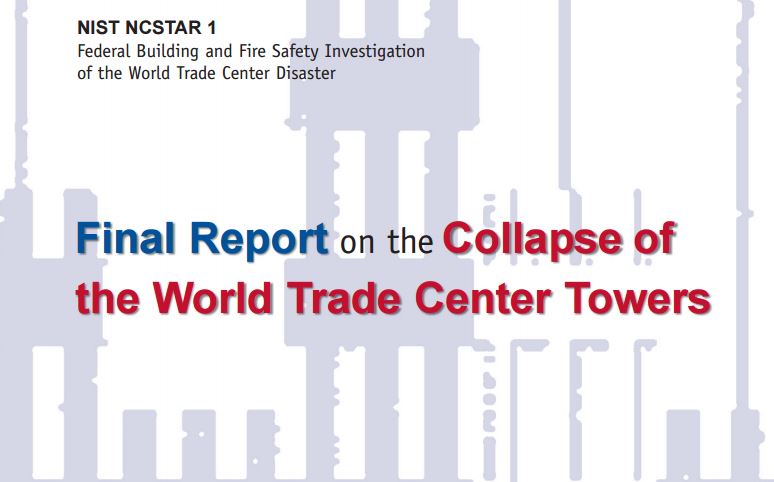Plan de la série « Les Tours Jumelles du World Trade Center » :
- I. La structure des tours jumelles
- II. Les crashs et les dégâts immédiats
- III. Les incendies
- IV. La fragilisation
- V. Les écroulements
- VI. Les fadaises 1 (chute libre, démolition contrôlée)
- VII. Les fadaises 2 (les architectes)
- VIII. Les fadaises 3 (thermite)
- IX. Les rapports d’enquêtes scientifiques
- 1/ Les rapports de la FEMA et du NIST
- 2/ Liens recommandés
- 3/ Les études scientifiques
- X En synthèse : que retenir ?
(le WTC 7 viendra plus tard)
VII. Les Rapports d’enquêtes scientifiques
1/ Les rapports de la FEMA et du NIST
Certaines personnes pensent que le rapport d’enquête scientifique (j’insiste, on en parle que de physique là) sur le WTC a été bâclé.
Il n’en est rien.
Dès 2002 est sortir un premier travail : le Rapport de la FEMA sur les effondrements des tours 1 et 2
Mai snesuite ets venu le colossal travail réalisé par le NIST en 2005 et 2008. Comme ils ont scindé ça en de multiples fichiers comme vous le voyez ici, je les ai rassemblés (mais comme ils sont très gros, ne les téléchargez que si vous en avez un grand besoin, sinon préférez le lien de la ligne précédente, qui ne fatiguera pas le serveur du blog…) :
NIST-0-Synthese (18 Mo)
NIST-1-Design-and-Construction-of-Structural-Systems (121 Mo)
NIST-2-Baseline-Structural-Performance-and-Aircraft-Impact-Damage-Analysis (130 Mo)
NIST-3-Mechanical-and-Metallurgical-Analysis-of-Structural-Steel (105 Mo)
NIST-4-Active-Fire-Protection-Systems (79 Mo)
NIST-5-Reconstruction-of-the-Fires (435 Mo)
NIST-6-Structural-Fire-Response-and-Probable-Collapse-Sequence (60 Mo)
NIST-7-Occupant-Behavior (5 Mo)
NIST-8-The-Emergency-Response-Operations (21 Mo)
En synthèse, j’ai aussi créé une version intégrale du rapport NIST en 1 seul pdf de… 12 000 pages, de 1 Go ici (mais je vous recommande de prendre les versions scindées, plus pratiques…).
2/ Liens recommandés
Enfin, je vous recommande les sites suivants pour approfondir (ou creuser d’autres théories conspirationnistes, c’est sans fin, puisque dès que vous démontrez qu’une théorie est fausse, ils vous en sortent une autre, de préférence sur un tout autre domaine de compétence…).
En français :
bastison.net de Jérôme Quirant
En anglais :
3/ Les études scientifiques
Rappelons également que de nombreux articles sont parus dans des revues à comité de lecture et n’ont bizarrement pas besoin d’explosifs pour expliquer les effondrements…
- Eagar, T.W., & Musso, C. Why Did the World Trade Center Collapse ? Science, Engineering, and Speculation JOM v. 53 N°12 2001
- Clifton, Charles G., Elaboration on Aspects of the Postulated Collapse of the World Trade Centre Twin Towers, Innovation in Metals 2001
- Pinsker, Lisa, M. Applying Geology at the World Trade Center Site Geotimes v. 46, no. 11 2001
- Zdenek P. Bazant, Yong Zhou Why Did the World Trade Center Collapse ? – Simple Analysis Journal of Engineering Mechanics v. 128 N°1 2002
- Anne Powell Dissecting the Collapses Civil Engineering ASCE v. 72 N°5 2002
- Quintiere, J.G.; di Marzo, M.; Becker, R. A suggested cause of the fire-induced collapse of the World Trade Towers, Fire Safety Journal v. 37 Issue 7 2002
- Newland, D. E.; Cebon, D. Could the world trade center have been modified to prevent its collapse ? Journal of Engineering Mechanics v. 128 Issue 7 2002
- Monahan, B. World Trade Center Collapse-Civil Engineering Considerations Practice Periodical on Structural Design and Construction v. 7, no. 3 2002
- Brannigan, F.L. WTC: Lightweight Steel and High-Rise Buildings Fire Engineeringv.155 no. 4 2002
- Fema Construction and Collapse Factors Fire Engineering v.155 no. 10 2002
- Corbett, G.P. Learning and Applying the Lessons of the WTC Disaster Fire Engineering v.155 no. 10 2002
- Norman J. Glover Collapse Lessons Fire Engineering v. 155 no. 10 2002
- Burgess, I.W. Fire Resistance of Framed Buildings Physics Education v. 37 (5) 2002
- Marechaux, T.G. TMS Hot Topic Symposium Examines WTC Collapse and Building Engineering JOM v. 54, no. 4 2002
- Wierzbicki, T.; Teng, X How the airplane wing cut through the exterior columns of the World Trade Center Journal of Impact Engineering v. 28 2003
- Usmani, A. S.; Chung, Y. C.; Torero, J. L How did the WTC towers collapse ? A new theory Fire Safety Journal v. 38 2003
- Gabrielson, T.B., Poese, M.E., & Atchley, A.A. Acoustic and Vibration Background Noise in the Collapsed Structure of the World Trade Center The Journal of Acoustical Society of America v. 113, no. 1 2003
- Biederman, R.R., Sullivan, E.M., Sisson Jr., R.D., Vander Voort, Microstructural analysis of the steels from Buildings 7, & 1 or 2 from the World Trade CenterMicroscopy and Microanalysis v. 9 2003
- Gayle, Frank W.; Banovic, Stephen W. Tim. Foecke The Structural Steel of the World Trade Center Towers Advanced Materials & Processes v. 162 no10 2004
- Nadine M. WTC Findings Uphold Structural Design ENR v. 253 no17 2004
- Marjanishvili, S.M. Progressive analysis procedure for progressive collapse Journal of Performance of Constructed Facilities v. 18 (2) 2004
- Corley, W.G. Lessons learned on improving resistance of buildings to terrorist attacks Journal of Performance of Constructed Facilities v. 18 (2) 2004
- Zhou, Q., Yu, T.X. Use of high-efficiency energy absorbing device to arrest progressive collapse of tall building Journal of Engineering Mechanics v. 130 (10) 2004
- Karim, Mohammed R.; Fatt, Michelle S. Hoo Impact of the Boeing 767 Aircraft into the World Trade Center. Journal of Engineering Mechanics v. 131 Issue 10 2005
- Usmani, A. S Stability of the World Trade Center Twin Towers Structural Frame in Multiple Floor Fires Journal of Engineering Mechanics v. 131 Issue 6 2005
- Omika, Yukihiro.; Fukuzawa, Eiji. Koshika, Norihide Structural Responses of World Trade Center under Aircraft Attacks Journal of Structural Engineering v. 131 no1 2005
- Chang, Jeremy; Buchanan, Andrew H.; Moss, Peter J Effect of insulation on the fire behaviour of steel floor trusses Fire and Materials v.29 : 4 2005
- Abolhassan, Genady P. Cherepanov September 11 And Fracture Mechanics, a Retrospective International Journal of Fracture v. 132 No. 2 2005
- Baum, H.R., Rehm, R.G., Quintiere, J.G. A simple model of the World Trade Center fireball dynamics Proceedings of the Combustion Institute 2005
- G. Flint, A.S. Usmani, S. Lamont, J. Torero and B. Lane, Effect of fire on composite long span truss floor systems Journal of Constructional Steel Research v. 62 (4) 2006
- Gayle, F.W., Banovic, S.W., Foecke, T., Fields, R.J., Luecke, W.E., McColskey, J.D., McCown, C., Siewert, T.A. The structural steel of the World Trade Center towers Journal of Failure Analysis and Prevention v. 6 (5) 2006
- Mohamed, O.A. Progressive collapse of structures: Annotated bibliography and comparison of codes and standards Journal of Performance of Constructed Facilities v. 20 (4) 2006
- Zdenek P. Bazant, Mathieu Verdure Mechanics of Progressive Collapse: Learning from World Trade Center and Building Demolitions Journal of Engineering Mechanics v. 133 No. 3 2007
- Banovic, S.W., Siewert, T.A. Failure of welded floor truss connections from the exterior wall during collapse of the world trade center towers Welding Journal v. 86 (9) 2007
- Gayle, F.W. The collapse of the world trade center towers: A metallurgist’s view MRS Bulletin v. 32 (9) 2007
- Hansen, B. Building code changes reflect world trade center investigation Civil Engineering v. 77 (9) 2007
- Graeme Flint, Asif Usmani, Susan Lamont, Barbara Lane, and Jose ToreroStructural Response of Tall Buildings to Multiple Floor Fires Journal of Structural Engineering v. 133 Issue 12 2007
- Ayhan Irfanoglu, Christoph M. Hoffmann An Engineering Perspective of the Collapse of WTC-1, Journal of Performance of Constructed Facilities v. 22 No. 1 2008
- Keith A. Seffen Progressive Collapse of the World Trade Centre: a Simple Analysis Journal of Engineering Mechanics v. 134 No. 2 2008
- Zdenek P. Bazant, Jia-Liang Le, Frank R. Greening, David B. Benson What Did and Did not Cause Collapse of WTC Twin Towers in New York Journal of Engineering Mechanics v. 134 2008
- Cherepanov, G.P. Collapse of towers as applied to September 11 events Materials Science v. 44 2008
- Kuligowski, E.D., Mileti, D.S. Modeling pre-evacuation delay by occupants in World Trade Center Towers 1 and 2 on September 11 Fire Safety Journal 2008
- Kodur, V.K.R. World Trade Center building disaster: Stimulus for innovations Indian Concrete Journal v. 82 2008
- Ming Wang, Peter Chang, James Quintiere, and Andre Marshall Scale Modeling of the 96th Floor of World Trade Center Tower 1 Journal of Performance of Constructed Facilities v. 21 Issue 6
- Genady P. Cherepanov Mechanics of the WTC collapse International Journal of Fracture v. 141 No. 1-2
- B.A. Izzuddin, A.G. Vlassis, A.Y. Elghazouli, D.A. Nethercot Progressive collapse of multi-storey buildings due to sudden column loss — Part I: Simplified assessment framework Engineering Structures v. 30, Issue 5 2008
- A.G. Vlassis, B.A. Izzuddin, A.Y. Elghazouli, D.A. Nethercot Progressive collapse of multi-storey buildings due to sudden column loss—Part II: ApplicationEngineering Structures v. 30, Issue 5 2008
- Jeom Kee Paik, Bong Ju Kim Progressive collapse analysis of thin-walled box columns Thin-Walled Structures v. 46, Issue 5 2008
- Cheol-Ho Lee, Seonwoong Kim, Kyu-Hong Han, Kyungkoo Lee Simplified nonlinear progressive collapse analysis of welded steel moment frames Journal of Constructional Steel Research v. 65 Issue 5 2009
- Feng Fu, Progressive collapse analysis of high-rise building with 3-D finite element modeling method Journal of Constructional Steel Research in press 2009
- A.G. Vlassis, B.A. Izzuddin, A.Y. Elghazouli, D.A. Nethercot, Progressive collapse of multi-storey buildings due to failed floor impact Engineering Structures in press 2009
- Santiago Pujol, J. Paul Smith-Pardo A new perspective on the effects of abrupt column removal Engineering Structures, v. 31, Issue 4 2009
- Hyun-Su Kim, Jinkoo Kim, Da-Woon An Development of integrated system for progressive collapse analysis of building structures considering dynamic effects Advances in Engineering Software v.40, Issue 1 2009
- Jinkoo Kim, Taewan Kim, Assessment of progressive collapse-resisting capacity of steel moment frames Journal of Constructional Steel Research v.65, Issue 1 2009
Et des conférences internationales spécialisées..
- Lu Xinzheng, Jiang Jianjing Simulation for the Collapse of WTC after Aeroplane Impact International Conference on Protection of Structures 2002
- Dr. Arden L. Bement, Jr. “Learning from 9/11: Understanding the Collapse of the World Trade Center” Committee of Science House of Representatives 2002
- Abboud, N., M. Levy, D. Tennant, J. Mould, H. Levine, S. King, C. Ekwueme, A. Jain, G. Hart. Anatomy of a Disaster: A Structural Investigation of the World Trade Center Collapses Third Congress on Forensic Engineering 2003
- Beyler, C., D. White, M. Peatross, J. Trellis, S. Li, A. Luers, D. Hopkin Analysis of the Thermal Exposure in the Impact Areas of the World Trade Center Terrorist Attacks Third Congress on Forensic Engineering 2003
- Thater, G. G.; Panariello, G. F.; Cuoco, D. A. World Trade Center Disaster: Damage/Debris Assessment Third Congress on Forensic Engineering 2003
- Choi, S.K., Burgess, I.W. and Plank, R.J. The Behaviour of Lightweight Composite Floor Trusses in Fire Designing Structures for Fire 2003
- Venkatash K. R. Kodur Role of fire resistance issues in the collapse of the Twin Towers International Conference on Tall Buildings 2003
- Abolhassan Astaneh-Asl World Trade Center Collapse, Field Investigation and Analysis the Ninth Arab Structural Engineering Conference 2003
- Mendonça, D., Lee II, E.E., Wallace, W.A. Impact of the 2001 World Trade Center attack on critical interdependent infrastructures IEEE International Conference on Systems 2004
- Kuldeep Prasad and Howard R. Baum Coupled fire dynamics and thermal response of complex building structures Proceedings of the Combustion Institute 2005
- Jowsey et all Determination of Fire Induced Collapse Mechanisms in Steel Framed Structures 4th European Conference on Steel and Composite Structures 2005
- Usmani et all Collapse scenarios of WTC 1 & 2 with extension to generic tall buildings Congress on Fire Safety in Tall Buildings 2006
- Marshall, A., Quintiere, J. A collective undergraduate class project reconstructing the September 11, 2001 world trade center fire ASEE Annual Conference and Exposition 2007
- Pfatteicher, S.K.A « A new era »: The limits of engineering expertise in a post-9/11 world International Symposium on Technology and Society 2007
- Razdolsky, L. Fire load in a steel building design 4th International Structural Engineering and Construction Conference 2008
- Rini, D., Lamont, S. Performance based structural fire engineering for modern building design Structures Congress 2008
Jérôme Quirant, professeur de Mécanique, indique : « Par contre j’ai eu beau chercher, à l’instant où j’écris ces lignes, je n’ai pas trouvé de publication remettant en cause le schéma d’effondrement décrit ici dans des revues reconnues. Des papelards écrits sur un bout de zinc du balto du coin, ça oui, on en trouve… »
P.S. Suivra bientôt une étude sur le WTC 7 (plus courte, c’est quasiment la même chose, impact de débris du WTC + incendies), donc merci de ne pas aborder ce sujet en commentaires.
N.B. : les séries sur le 11 Septembre sont évidemment lourdes à modérer. Comme vous le voyez dans le plan au début du billet, ce billet s’insère dans une longue série. Merci donc de ne pas commenter sur de sujets qui seront clairement traités par la suite, cela fait perdre du temps à tout le monde. Vous pouvez commenter la série dans ce billet dédié.




















Les commentaires sont fermés.